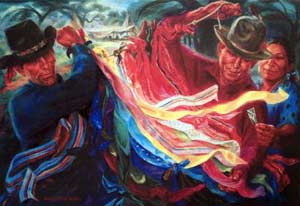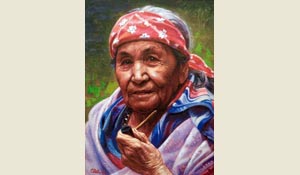 |
home | media | press | touring | merchandise | contact about |
|||
|---|---|---|---|---|
|
“Woody is just Woody. Thousands of people do not know he has any The following excerpt of biographical material was borrowed from WOODY GUTHRIE was born on July 14, 1912, in Okemah, Oklahoma. He was the second-born son of Charles and Nora Belle Guthrie. His father – a cowboy, land speculator, and local politician – taught Woody Western songs, Indian songs, and Scottish folk tunes. His Kansas-born mother, also musically inclined, had an equally profound effect on Woody. Slightly built, with an extremely full and curly head of hair, Woody was a precocious and unconventional boy from the start. Always a keen observer of the world around him, the people, music and landscape he was exposed to made lasting impressions on him. During his early years in Oklahoma, Woody experienced the first of a series of immensely tragic personal losses. With the accidental death of his older sister Clara, the family's financial ruin, and the institutionalization and eventual loss of his mother, Woody's family and home life was forever devastated. In 1920, oil was discovered nearby and overnight Okemah was transformed into an "oil boom" town, bringing thousands of workers, gamblers and hustlers to the once sleepy farm town. Within a few years, the oil flow suddenly stopped and Okemah suffered a severe economic turnaround, leaving the town and its inhabitants "busted, disgusted, and not to be trusted." From his experiences in Okemah, Woody’s uniquely wry outlook on life, as well as his abiding interest in rambling around the country, was formed. And so, he took to the open road. In 1931, when Okemah's boomtown period went bust, Woody left for Texas. In the panhandle town of Pampa, he fell in love with Mary Jennings, the younger sister of a friend and musician named Matt Jennings. Woody and Mary were married in 1933, and together had three children, Gwen, Sue and Bill. It was with Matt Jennings and Cluster Baker that Woody made his first attempt at a musical career, forming The Corn Cob Trio and later the Pampa Junior Chamber of Commerce Band. It was also in Pampa that Woody first discovered a love and talent for drawing and painting, an interest he would pursue throughout his life. If the Great Depression made it hard for Woody to support his family, the onslaught of the Great Dust Storm period, which hit the Great Plains in 1935, made it impossible. Drought and dust forced thousands of desperate farmers and unemployed workers from Oklahoma, Kansas, Tennessee, and Georgia to head west in search of work. Woody, like hundreds of “dustbowl refugees,” hit Route 66, also looking for a way to support his family, who remained back in Pampa. Moneyless and hungry, Woody hitchhiked, rode freight trains, and even walked his way to California, taking whatever small jobs he could. In exchange for bed and board, Woody painted signs and played guitar and sang in saloons along the way, developing a love for traveling the open road—a lifelong habit he would often repeat. . . . . click here to go to Woody Guthrie Publications and continue the story. |
|
|
CHARLES BANKS WILSON was born in Arkansas in 1918, his family eventually moving to Miami, Oklahoma where he spent his childhood. A painter, printmaker, teacher, lecturer, historian, magazine and book illustrator, Wilson's work has been shown in over 200 exhibitions in the United States and across the globe. Permanent collections of Wilson's work are housed in some of the most renowned museums and art galleries in the world. These include New York's Metropolitan Museum, Washington's Library of Congress, the Corcoran Gallery and the Smithsonian. Many of Wilson’s works hang in the Oklahoma State Capitol including life-size portraits of Will Rogers, Sequoyah, Carl Albert, and Senator Robert Kerr. Four other murals depicting Oklahoma history also hang under the Capitol dome. In addition to being the author and editor of a standard work on the Indian Tribes of Eastern Oklahoma, he is also the illustrator of 22 books and has contribed illustrations to many more. He is best known for his pictures of contemporary Indian life. Honored by the U.S. State Department as well as the International Institute of Arts and Letters in Geneva, Charles Banks Wilson received the first Governor's Art Award and the D.S.C. (Distinguished Service Citation ) from the University of Oklahoma. Wilson is also honored in the Oklahoma Hall of Fame, received the Western Heritage award from the Cowboy Hall of Fame. Wilson established the Art Department at Northeastern Oklahoma A&M College, which he chaired for 15 years; and the Charles Banks Wilson Scholarship has helped many young artists who have wanted to study there. He is a Fellow of the International Institution of Arts and Letters, a member of the Oklahoma Hall of Fame and is the recipient of the Lifetime Achievement Award from the Arkansas Arts Council. Wilson was commissioned to paint the portraits of Will Rogers, Sequoyah, Robert Kerry, Jim Thorpe and Woody Guthrie for the Oklahoma State Capitol rotunda. He has also been awarded the Oklahoma Governor’s Art Award and was the subject of a documentary titled ‘Portrait of an American Artist.’ He was named an Oklahoma Treasure by the Governor’s Arts Awards in 2001. - - - - - - - - - - We lost this good friend on May 2, 2013. He will be missed... |
|
home | about | media | press | touring | merchandise | contact
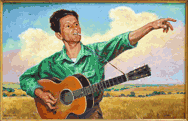
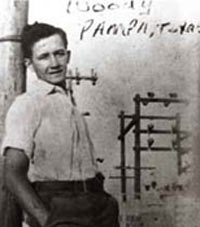
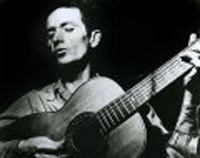
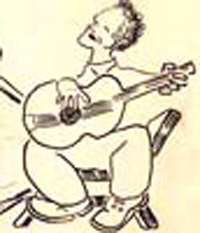
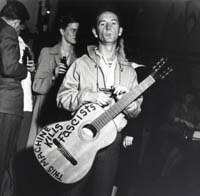
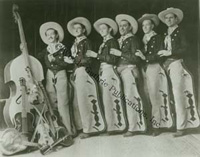
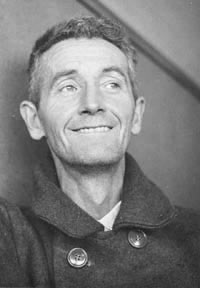
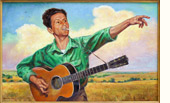 The painting of Woody Guthrie that has come to represent "Woody Sez" is one of many beautiful works by Charles Banks Wilson (see self portrait at right) who, along with the Oklahoma State Senate Historical Preservation Fund, has kindly allowed us its use. The following biographical information for Mr. Wilson was found at Wikipedia.
The painting of Woody Guthrie that has come to represent "Woody Sez" is one of many beautiful works by Charles Banks Wilson (see self portrait at right) who, along with the Oklahoma State Senate Historical Preservation Fund, has kindly allowed us its use. The following biographical information for Mr. Wilson was found at Wikipedia.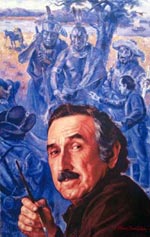
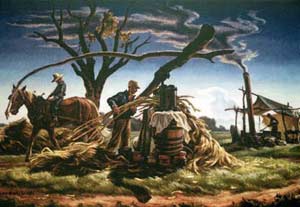
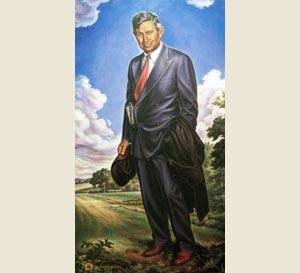 WILL ROGERS (giclée with oil on canvas)
WILL ROGERS (giclée with oil on canvas)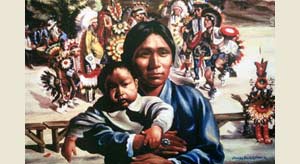 BIRTHRIGHT (giclée with oil on canvas)
BIRTHRIGHT (giclée with oil on canvas)